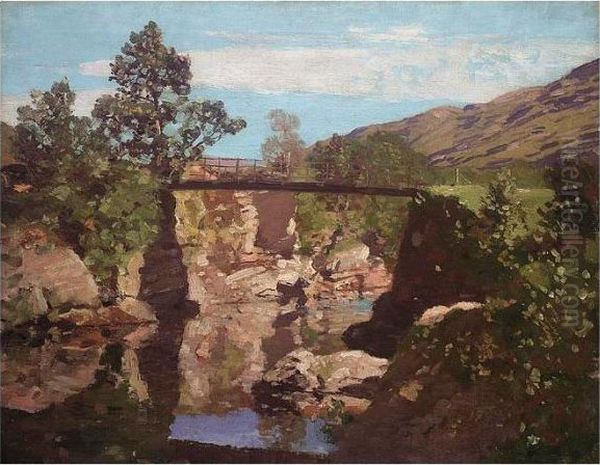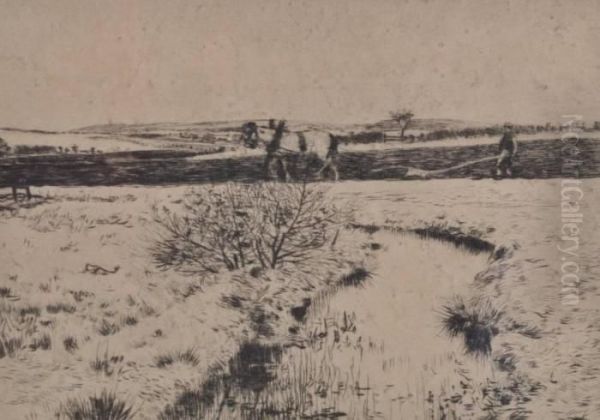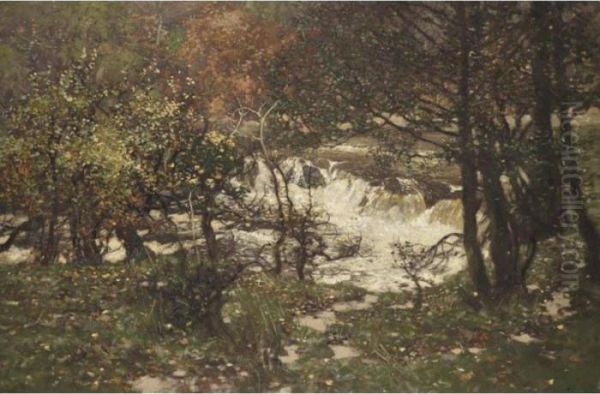George Houston, born in 1869 and passing away in 1947, stands as a significant figure in the annals of Scottish art. A painter deeply devoted to the landscapes of his homeland, Houston worked primarily in oils and watercolours, becoming one of the most respected interpreters of the Scottish countryside during the late 19th and early 20th centuries. His career unfolded during a vibrant period for Scottish art, and he carved out a distinct niche for himself through his commitment to outdoor painting and his sensitive rendering of light and atmosphere. Associated with the later developments influenced by Impressionism in Scotland, his work offers a compelling vision of place, particularly his beloved Ayrshire.
Houston's art is characterised by its directness, its freshness, and its profound connection to the natural world. He was not a painter of grand historical narratives or complex allegories; instead, he found his inspiration in the fields, coasts, lochs, and ever-changing skies of Scotland. His legacy is that of an artist who captured the essence of his environment with honesty and skill, leaving behind a body of work that continues to resonate with viewers who appreciate finely observed landscape painting. His dedication to his craft earned him recognition within the established art institutions of his day, solidifying his place in Scottish art history.
Early Life and Artistic Formation
George Houston was born in the town of Dalry, North Ayrshire, in 1869. Growing up in this region profoundly shaped his artistic vision, instilling in him a lifelong attachment to its specific landscapes, light, and weather patterns. Ayrshire, with its rolling hills, agricultural lands, and proximity to the Firth of Clyde, would become the heartland of his artistic output. His early inclination towards art led him to seek formal training, initially pursuing studies locally before moving on to a major centre of artistic education in Scotland.

His most significant period of formal training took place at the renowned Glasgow School of Art. He enrolled during a period when Glasgow was buzzing with artistic energy. The group known as the "Glasgow Boys" – including figures like Sir James Guthrie, Sir John Lavery, George Henry, and E. A. Hornel – had already challenged the conservative norms of the Scottish art establishment with their embrace of realism and plein air painting, often influenced by French models like Jules Bastien-Lepage. While Houston was slightly younger and developed his own distinct style, the environment fostered by these predecessors undoubtedly created a fertile ground for landscape painting and experimentation.
To further broaden his horizons, Houston also spent some time studying in Paris, reportedly at the Académie Julian. This experience, common for ambitious artists of his generation, would have exposed him directly to contemporary French art, including the ongoing developments of Impressionism and Post-Impressionism. However, Houston's work never fully adopted the broken colour techniques or high-keyed palette of French Impressionism in the manner of Claude Monet or Camille Pissarro. Instead, he absorbed lessons about light and atmospheric effect, adapting them to the specific conditions and traditions of Scottish painting.
The Call of the Landscape: Ayrshire and Beyond
Returning to Scotland, Houston settled back in his native Ayrshire, establishing his home and studio in Dalry. His commitment to painting the landscape directly from nature became the defining characteristic of his practice. He was a devoted advocate of plein air painting, believing that only by working outdoors could he truly capture the fleeting effects of light, weather, and atmosphere that animated the Scottish scenery. This dedication set him apart and infused his work with a sense of immediacy and authenticity.
His deep familiarity with Ayrshire allowed him to depict its varied moods with exceptional sensitivity. He painted its fields under snow, its rivers winding through valleys, its country roads dappled with sunlight, and its skies heavy with rain or illuminated by dramatic sunsets. He became, in essence, the visual chronicler of his home region. His approach echoed the earlier commitment to outdoor work seen in the pioneering Scottish landscape painter William McTaggart, often considered a precursor to Scottish Impressionism, whose vigorous brushwork and focus on light and weather effects were highly influential.

Houston's dedication to plein air work was legendary. He was known to paint outdoors in all conditions, enduring the often harsh Scottish weather to capture a specific effect. To facilitate this, he reportedly used a specially adapted motorcar or a small portable hut as a mobile studio, allowing him to work on location with some degree of shelter. This practical approach underscores his determination to confront the landscape directly, rather than relying solely on sketches worked up later in the studio. This method aligns him with contemporaries like James Paterson, another notable Scottish landscape painter dedicated to capturing the nuances of the Scottish countryside.
While Ayrshire remained his primary focus, Houston's artistic explorations also took him to other parts of Scotland. He painted frequently on the Isle of Iona, a location famous for its unique light quality, historical significance, and its attraction for artists, including later figures like Samuel Peploe and F.C.B. Cadell of the Scottish Colourists. He also depicted scenes along the Fife coast on the eastern side of Scotland, capturing the different character of its fishing villages and coastal light compared to the west. Loch Fyne and other areas of the West Highlands also featured in his work, showcasing his ability to respond to diverse Scottish terrains.
Style and Technique: Light, Atmosphere, and Impressionism
George Houston's style is best understood within the context of Scottish Impressionism, a term often used to describe the work of artists influenced by, but distinct from, their French counterparts. Houston's work typically emphasizes atmosphere and tonal harmony over the scientific analysis of light and broken colour often seen in French Impressionism. He was a master at capturing the soft, diffused light, the moisture-laden air, and the dramatic, rapidly changing weather patterns characteristic of Scotland.
His brushwork is often described as direct, confident, and fluid. He frequently employed a square brush technique, applying paint in broad, distinct strokes that define form and capture texture without excessive detail. This method contributes to the freshness and vigour of his surfaces. While his palette could be vibrant, particularly in depicting sunlit scenes or autumnal colours, it often retained a sensitivity to the subtle greys, blues, and greens prevalent in the Scottish landscape, especially under overcast skies or during winter months.

Houston worked proficiently in both oil paint and watercolour. His watercolours, often possessing a remarkable transparency and luminosity, demonstrate his skill in handling this demanding medium. They frequently served as studies for larger oil paintings but are often highly accomplished works in their own right. His membership in the Royal Scottish Society of Painters in Watercolour (RSW) attests to his standing in this field. Whether working in oil or watercolour, his primary aim remained consistent: to convey the mood and feeling of a specific place at a particular moment in time.
While influenced by Impressionist ideas about capturing fleeting moments and the effects of light, Houston's work also shows connections to earlier landscape traditions, such as the French Barbizon School painters like Jean-Baptiste-Camille Corot, known for their poetic and atmospheric depictions of nature. There might also be affinities with the tonal approaches of the Hague School in the Netherlands, whose artists like Anton Mauve excelled at portraying rural scenes and coastal weather. Houston synthesized these influences into a personal style deeply rooted in Scottish sensibilities.
Recognition and Career
George Houston's commitment and talent did not go unnoticed by the Scottish art establishment. He began exhibiting his work regularly at major venues, including the Royal Scottish Academy (RSA) in Edinburgh and the Royal Glasgow Institute of the Fine Arts (RGI). His distinctive landscapes quickly found favour with critics and collectors alike, drawn to their atmospheric quality and authentic portrayal of familiar Scottish scenes. His work became a regular feature of the annual exhibitions, contributing to the strong current of landscape painting in Scotland at the time.
His growing reputation led to formal recognition from the country's leading art institution. In 1909, George Houston was elected an Associate of the Royal Scottish Academy (ARSA). This was a significant honour, marking his acceptance into the upper echelons of the Scottish art world. He continued to exhibit consistently and develop his art, further solidifying his position. His dedication and artistic achievements culminated in his election as a full Academician of the Royal Scottish Academy (RSA) in 1924, allowing him to use the prestigious post-nominal letters "R.S.A."
Beyond Scotland, Houston also exhibited occasionally at the Royal Academy of Arts in London and other venues in England, such as the Walker Art Gallery in Liverpool. This exposure helped to bring his work to a wider British audience. Throughout his career, his paintings were sought after by private collectors, and his work gradually entered public collections, ensuring its preservation and accessibility for future generations. He maintained a steady output, driven by his unwavering passion for the Scottish landscape.
Notable Works and Subjects

While identifying a single definitive list of "most famous" works can be challenging for an artist with a consistent output like Houston's, certain paintings and recurring subjects stand out. Landscape in Ayrshire, often dated to around 1910, is frequently cited as one of his most significant and ambitious works. Such paintings typically encapsulate his strengths: a broad, atmospheric view of the Ayrshire countryside, perhaps under a dynamic sky, rendered with confident brushwork and a keen sense of place. Works like this exemplify the "Houston style" that became so recognizable.
The title A Country Road, mentioned in some sources, represents a common and characteristic theme for Houston. He painted numerous variations of rural lanes winding through fields, often using the road as a compositional device to lead the viewer's eye into the landscape. These scenes allowed him to explore the interplay of light and shadow under trees, the changing colours of the seasons in the hedgerows and fields, and the quiet, unassuming beauty of the working countryside.
His depictions of the Scottish coast, whether the rugged shores of Ayrshire and the West Highlands or the fishing villages of Fife, form another important part of his oeuvre. He captured the tang of sea air, the movement of waves, and the distinctive light found where land meets water. His paintings of Iona, in particular, often convey the island's special atmosphere, with its wide skies and luminous seascapes. Winter scenes were also a recurring subject, allowing him to explore the subtle harmonies of whites, greys, and blues, and the stark beauty of the landscape under snow.
Houston and his Contemporaries
George Houston's career unfolded alongside many other talented Scottish artists, and understanding his place requires considering this broader context. He emerged after the initial impact of the "Glasgow Boys," such as James Guthrie, John Lavery, E. A. Hornel, George Henry, and Arthur Melville. While sharing their interest in realism and plein air work, Houston's style generally remained more focused on traditional landscape representation, less concerned with the decorative patterning or Symbolist undertones that appeared in some of the Glasgow Boys' work, particularly that of Hornel and Henry.
He was a contemporary of other notable Scottish landscape painters who shared a similar focus on capturing the national scenery. E. A. Walton, another original Glasgow Boy, continued to produce sensitive landscapes. Alexander Roche also painted evocative Scottish scenes. David Young Cameron, while perhaps more famous internationally for his etchings, was also a highly accomplished landscape painter in oils, known for his majestic and often stark portrayals of the Scottish Highlands. Robert Gemmell Hutchison specialised in coastal scenes and genre subjects, often featuring children, rendered with an Impressionistic touch.
Houston's work also overlapped with the emergence of the Scottish Colourists – Samuel John Peploe, F.C.B. Cadell, Leslie Hunter, and J.D. Fergusson (though Fergusson spent much time abroad). The Colourists, active mainly from the early 1900s through the 1930s, pushed Scottish art in a different direction, embracing a bolder, more arbitrary use of colour and simplified forms, heavily influenced by French Fauvism and Post-Impressionism. While Houston's approach remained more naturalistic and atmospheric, there was a shared interest, particularly with Peploe and Cadell in their landscape phases, in the effects of light and the depiction of specific Scottish locations like Iona. Houston represents a continuation of the Impressionist-influenced landscape tradition, while the Colourists forged a more modernist path.
Other contemporaries included figures like James Paterson, known for his landscapes of Dumfriesshire, and Joseph Crawhall II, associated with the Glasgow Boys but known primarily for his exceptional watercolours of animals. Houston navigated this rich artistic milieu, maintaining his own distinct voice focused on the direct, atmospheric portrayal of the Scottish landscape, particularly his native Ayrshire.
Later Life and Legacy
George Houston continued to paint actively throughout his life, remaining dedicated to his chosen subject matter. His connection to Ayrshire endured, and he maintained his home and studio in Dalry. In his personal life, he married Virginia Card, who was described as a light opera singer. His life appears to have been relatively stable, centred around his artistic practice and his engagement with the Scottish art world through exhibitions and his membership in the RSA and RSW.
He passed away in 1947 at the age of 78 (some sources incorrectly state 1944, but 1947 is generally accepted by major institutions). By the time of his death, he had established a solid reputation as one of Scotland's foremost landscape painters of his generation. His work had consistently found an appreciative audience, and his contribution to the tradition of Scottish landscape painting was widely acknowledged.
George Houston's legacy lies in his authentic and atmospheric depictions of the Scottish landscape. He successfully adapted lessons from European art movements like Impressionism to the specific light and character of his homeland. His dedication to plein air painting resulted in works that possess a freshness and immediacy, capturing the transient moods of nature with skill and sensitivity. He stands as a key figure in the lineage of Scottish landscape art that stretches from Horatio McCulloch through William McTaggart and continues into the 20th century.
Today, George Houston's paintings are held in numerous public collections across Scotland and the UK. Major institutions holding his work include the Kelvingrove Art Gallery and Museum in Glasgow, the National Galleries of Scotland in Edinburgh, the McLean Museum and Art Gallery in Greenock, Paisley Museum and Art Galleries, and the Hunterian Art Gallery at the University of Glasgow, among others. His work also appears regularly at auction, indicating continued appreciation among collectors.
Conclusion
George Houston (1869-1947) was a quintessential Scottish landscape painter. Deeply rooted in his native Ayrshire, he dedicated his career to capturing the unique beauty, light, and atmosphere of his homeland. As a committed plein air artist, he brought a sense of immediacy and authenticity to his depictions of fields, coasts, and skies. While influenced by broader European trends like Impressionism, he forged a personal style perfectly suited to the nuances of the Scottish environment. His election to the Royal Scottish Academy confirmed his standing within the art establishment of his time. Through his prolific output in both oil and watercolour, George Houston created an enduring visual record of Scotland, securing his place as a significant and much-loved figure in the nation's rich artistic heritage. His work continues to offer a compelling window onto the landscapes he knew so intimately.